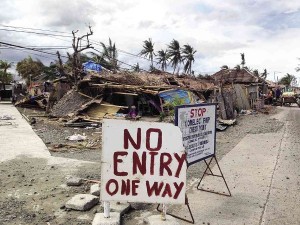Philippines launches $8.17B Haiyan rebuilding plan

SEVERAL days after the onslaught of Supertyphoon “Yolanda,” residents in New Washington town, Aklan province, struggle to rebuild their homes and their lives. MARICAR CINCO/INQUIRER SOUTHERN LUZON
MANILA, Philippines—The Philippine government launched an $8.17 billion plan on Wednesday to rebuild the lives of millions battered by Supertyphoon Yolanda (international name: Haiyan).
President Benigno Aquino III appealed for international assistance and private sector pledges to help his government rehabilitate hundreds of devastated communities and increase their resilience to natural disasters as well as the adverse impacts of climate change.
“The task immediately before us lies in ensuring that the communities that rise again do so stronger, better and more resilient than before,” he told foreign diplomats and aid officials in a speech at the launch of the initiative.
“Every dollar of funding assistance will be used in as efficient and as lasting a manner as possible,” he pledged.
Haiyan left nearly 8,000 people dead or missing after it struck the central islands on November 8, wrecking more than a million houses with 315 kilometers (195 miles) per hour winds and giant tsunami-like waves created by storm surges.
Article continues after this advertisementAquino said the typhoon, one of the strongest to ever hit land and already the second-deadliest natural disaster in the history of the storm-prone Philippines, caused $12.9 billion in damage and destruction.
Article continues after this advertisementThe economic planning department said the government’s rehabilitation plan called for spending 360.9 billion pesos ($8.17 billion) over a four-year-period until 2017, according to the document released Wednesday.
Donors will be asked to put up some of the costs, it said, but no breakdown was given.
In his speech, Aquino thanked the global community for the outpouring of support for the typhoon victims. But he stressed there was still much more work to do.
“Your help is all the more necessary today, because in confronting the escalating effects of climate change the resources of countries like the Philippines will be strained to the limit,” he said.
He said the plan involves both meeting immediate as well a longer-term needs as the devastated communities attempt to get back to normalcy, with food aid expected to be needed until March next year at the latest.
“From now until December 2014 we will be preoccupied with critical immediate investments such as the rebuilding and repair of infrastructure and the construction of temporary houses,” he said.
“Large investments will be spread over multiple years and will hopefully be completed by 2017 if not earlier.”
The United Nations this week also launched a $791 million aid appeal to take care of the survivors’ needs over the next 12 months.